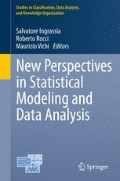Abstract
The paper presents an unsupervised procedure for the evaluation of the firm financial status, aiming at identifying a potentially weak level of solvency of a company through its positioning in a segmented sector. Model Based Clustering is, here, used to segment real datasets concerning sectoral samples of industrial companies listed in five European stock exchange markets.
Access this chapter
Tax calculation will be finalised at checkout
Purchases are for personal use only
Preview
Unable to display preview. Download preview PDF.
References
Altman, E. (1968). Financial ratios, discriminant analysis and the prediction of corporate bankruptcy. The Journal of Finance, 23(4), 589–609.
Atkinson, A. C., Riani, M., & Cerioli, A. (2010). Robust clustering for performance evaluation. In F. Palumbo et al. (eds.), Data analysis and classification(pp. 381–390). Berlin Heidelberg: Springer-Verlag.
Azadeh, A., Ghaderi, S. F., Miran, Y. P., Ebrahimipour, V., & Suzuki, K. (2007). An integrated framework for continuous assessment and improvement of manufacturing system. Applied Mathematics and Computation, 186, 1216–1233.
Banfield, J. D., & Raftery, A. E. (1993). Model-based Gaussian and non-Gaussian clustering. Biometrics, 49(3), 803–821.
Beaver, W. H. (1966). Financial ratios as predictors of failure. Journal of Accounting Research, Empirical Research in Accounting: Selected Studies, 4, 71–111.
Bensmail, H., & De Gennaro, R. (2004). Analyzing imputed financial data: A new approach to cluster analysis. Federal Reserve Bank of Atlanta-Working Paper Series, 20.
Chen, W. S., & Du, Y. K. (2009). Using neural networks and data mining techniques for the financial distress prediction models. Expert system with Application, 36, 4075–4086.
Dimitras, A. I., Slowinski, R., Susmaga, R., & Zopounidis, C. (1999). Business failure prediction using rough sets. European Journal of Operational Research, 114, 263–280.
Fraley, C., & Raftery, A. E. (2002). Model-based clustering, discriminant analysis and density estimation. Journal of the American Statistical Association, 97(458), 611–631.
Gupta, M. C., & Huefner, R. J. (1972). A cluster analysis study of financial ratios and industry characteristics. Journal of Accounting Research, 10(1), 77–95.
Ingrassia, S., & Rocci, R. (2007). Constrained Monotone EM Algorithms for finite mixtures of multivariate Gaussians. Computational Statistics and Data Analysis, 51, 5339–5351.
Jain, A. K., Murty, M. N., & Flinn, P. J. (1999). Data clustering: A review. ACM Computing Surveys, 31(3).
Jo, H., Han, I., & Lee, H. (1997). Bankruptcy prediction using case-based reasoning, neural networks, and discriminant analysis. Expert System with Application, 13(2), 97–108.
Lee, K., Booth, D., & Alam, P. (2005). A comparison of supervised and unsupervised neural networks in predicting bankruptcy of Korean firms. Expert system with Application, 29, 1–16.
Lensberg, T., Eilifsen, A., Mckeee, T. E. (2006). Bankruptcy theory development and classification via genetic programming: Some methodological issues. European Journal of Operational Research, 169, 677–697.
Ohlson, J. A. (1980). Financial ratios and the probabilistic prediction of bankruptcy. Journal of Accounting Research, 18(1), 109–131.
Peel, D., & McLachlan, G. J. (2000). Robust mixture modelling using the distribution. Statistics and Computing10, 339–348.
Sun, J., & Li, H. (2008). Data mining method for listed companies financial distress prediction. Knowledge-Based Systems, 21, 1–5.
Sun, L., & Shenoy, P. P. (2007). Using bayesian networks for bankruptcy prediction: Some methodological issues. European Journal of Operational Research, 180(2), 738–753.
Taffler, R. J. (1982). Forecasting company failure in the UK using discriminant analysis and financial ratio data. Journal of the Royal Statistical Society. Series A, 145(3), 342–358.
Tam, K. Y., & Kiang, M. Y. (1992). Application of neural networks: The case of bank failure predictions. Management Science, 38(7), 926–947.
Rezaie, K., Dehghanbaghi, M., & Ebrahimipour, V. (2009). Performance evaluation of manufacturing systems based on dependability management indicators-case study:chemical industry. International Journal of Manufacturing Technology & Management, 43, 608–619.
Vichi, M., Rocci, R., & Kiers, H. A. L. (2007). Simultaneous component and clustering models for three-way data: within and between approaches. Journal of Classification, 24, 71–98.
Zmijewski, M. E. (1984). Methodological issues related to the estimation of financial distress prediction models. Journal of Accounting Research, 22, 59–82.
Author information
Authors and Affiliations
Corresponding author
Editor information
Editors and Affiliations
Rights and permissions
Copyright information
© 2011 Springer-Verlag Berlin Heidelberg
About this paper
Cite this paper
Cutugno, C. (2011). An Analysis of Industry Sector Via Model Based Clustering. In: Ingrassia, S., Rocci, R., Vichi, M. (eds) New Perspectives in Statistical Modeling and Data Analysis. Studies in Classification, Data Analysis, and Knowledge Organization. Springer, Berlin, Heidelberg. https://doi.org/10.1007/978-3-642-11363-5_12
Download citation
DOI: https://doi.org/10.1007/978-3-642-11363-5_12
Published:
Publisher Name: Springer, Berlin, Heidelberg
Print ISBN: 978-3-642-11362-8
Online ISBN: 978-3-642-11363-5
eBook Packages: Mathematics and StatisticsMathematics and Statistics (R0)

